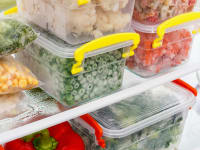When the power goes out, here’s what to do
Whatever you do, don't open the fridge just yet
Products are chosen independently by our editors. Purchases made through our links may earn us a commission.
Power outages: They're always an inconvenience, but can quickly turn into a dangerous situation. Whether it's from downed power lines due to a storm or electrical equipment failure, a power outage can happen in an instant. While you might not be able to predict exactly when one will strike, you can most definitely prepare ahead.
In addition to some proactive prepping, there are a few steps you'll want to take just after the power goes out to keep your perishable food and electronics safe, along with safety tips you should follow for generator use if you've got one.
As chilling temperatures and powerful snowstorms move throughout the country, now is as good a time as any to be prepared with the tools and knowledge to keep you and your home safe during a potential power outage.
If you’re stuck in the dark, here’s what to do to manage until the lights come back on.
Use candles with caution
Especially in the nighttime hours, it can be hard to navigate the home without any lighting. If you have any flashlights or battery-powered candles, use those first.
If you’re in a pinch, you can use candles, as long as you use them safely and don’t leave one burning unattended.
The CDC says if you must use candles, use candle holders and place candles away from anything that could be flammable.
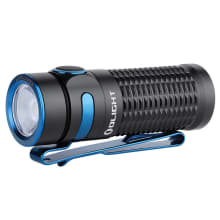
It's a good idea to keep a rechargeable flashlight on-hand for power outages.
Understand when to open the fridge—and when to not
When the power goes out, one of your first concerns might be your food supply. That’s why it’s important to safely store and manage your refrigerated food, especially if you don’t have a backup emergency kit with non-perishable food.
Once the power goes out, try not to open your fridge or freezer unless absolutely necessary. According to the American Red Cross, an unopened refrigerator will keep food cold for about 4 hours, while an unopened full freezer will keep the temperature for about 48 hours (or 24 hours if it is half full).
Unfortunately, if the power goes out for an extended period of time, there's a chance you'll end up having food waste. Once the power is restored, there are a few things you can do to see if your food is still safe to eat or not. If you have a food thermometer on hand, measure the temperature of your food in the fridge—the FDA says food under 45 degrees Fahrenheit or below is safe to consume if the power was out for no more than four hours.
Ready.gov recommends throwing out perishable foods—dairy products, meats, fish, soft cheeses, and cooked vegetables—that have been exposed to temperatures 40 degrees Fahrenheit or higher for two hours or more. Additionally, it should be tossed if the food has a new or unusual odor, color, or texture.
If you’re still unsure if your food is safe, it’s best to err on the side of caution and dispose of it.
For future power outages, especially those you come home to without knowing how long it’s been out, you can use the “quarter on a cup” method to get a visual idea of your freezer temps. Simply freeze a cup of water, then put it in the refrigerator with a quarter on top of it before you leave your home.
Jonathan Chan, Senior Manager of Lab Operations at Reviewed, explains, “If the quarter [remains] on top, you're fine; but, if it [has sunk] more than half an inch down, your food has been exposed to warm temperatures for a prolonged period of time.”
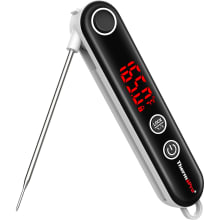
A digital thermometer can help you determine which food items are safe and which are spoiled.
Unplug your electronics and appliances
Just after the power goes out, make it a priority to walk through your home and disconnect all appliances and electronics from wall outlets—this includes things like microwaves, washers and dryers, and computers. Doing so will avoid power surge damage, which can happen instantly once power is restored.
If you have a surge protector, plug your most important items into it to avoid damaging them.
Additionally, try to keep one light plugged in—or use a light that’s wired into your home—and make sure it’s turned on so you’ll know if power has been restored.
Avoid using a gas stove or oven as a heat source to stay warm. Not only should these appliances be unplugged, but using them to heat the home can pose a fire danger and can create harmful carbon monoxide fumes.
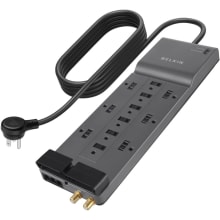
A surge protector can help protect your most important electronics from getting damaged.
Use your generator, but do so safely
In the event of a blackout, a backup generator can keep vital appliances like your heating and cooling systems up and running. However, they must be used properly or can result in more harm than good.
Generators produce carbon monoxide, a colorless and odorless gas that can result in sickness or death and can also pose other dangers like electrocution or fire if not used safely.
The first rule of thumb when it comes to generator safety—no matter if it’s a standby or portable generator—is to never, ever use them indoors. OSHA recommends keeping generators outdoors, away from doors, windows, or vents where exhaust fumes could potentially enter the home.
Many power outages come as a result of a serious storm. While you may want to use your generator right as the storm passes through, you should not use it in rainy or wet conditions. At all times, your generator should sit under some sort of canopy-like structure, to keep it safe and dry.
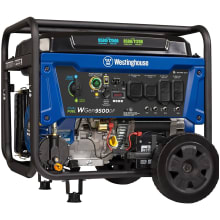
A portable generator ensures you always have access to power during a blackout.
Keep electronics, like phones, charged
While hand-crank radios are great for getting vital information when you don’t have power, having charged electronics—especially a charged cell phone—can be essential for staying in the know about your area’s safety and power outage status.
One smart tip is to charge your phone via your laptop. It doesn’t have to be connected to a power source, so you use whatever battery life your laptop has left to keep your cell phone going.
You can also charge electronics in the car for a while. If your car is parked in your garage, don’t stay in the space if you plan on letting the car run. You want to avoid high levels of carbon monoxide.
If you happen to be caught off guard without fully charged electronics, or the power outage goes on for an extended period of time, you may need some extra power backup. A portable battery pack is a must-have for this reason, and can even come in handy beyond a power outage. A reliable and powerful battery pack we've tested is the Mophie PowerStation PD. With 18 Watts of power—enough to charge two phones at once—this may come in handy if you're looking to charge up your phone or other electronic devices.
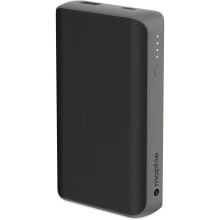
A power station can help keep your phone charged during blackouts, so you'll always have it on hand for emergencies.
Hunker down in a safe spot
If you’ve decided to stay put in the house, stay in a central spot that you know will be safe to navigate during the day and nighttime hours to avoid any accidental trips or falls. You can concentrate your battery-powered lights and candles in this area to keep it well-lit.
If you are sheltering in place, make sure you can evacuate it without complications. For example, consider accessibility needs. If someone in your home relies on a stairlift that requires electricity to function, shelter on the ground level of your home unless there is potential for something like a flood to occur.
Evaluate your local situation
Every emergency scenario is different, so it’s important to stay in the know about your local situation. If you have a hand-crank radio on hand or are signed up for phone alerts from local officials, be sure to follow local guidelines as the emergency situation evolves.
Additionally, it’s possible that your home may become a place that’s too hot, too cold, or just plain dangerous to be in during an emergency situation. If you feel that the best next step is to evacuate to a public shelter, be sure to follow the latest CDC guidelines.

It's important to have multiple means of accessing information during emergencies.



